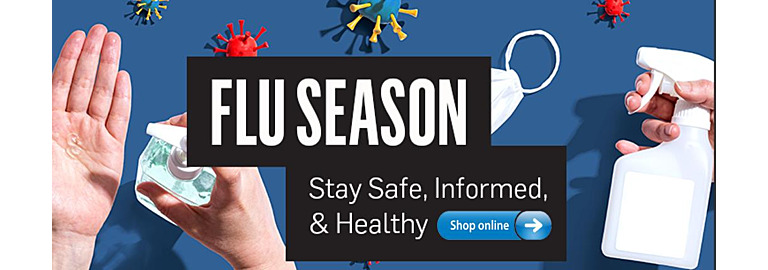Get Ready for Flu Day
There’s no doubt about it. Cold and flu season is a sure thing. And it’s coming whether you’re ready or not. Nothing will take away all the risk of getting a cold or the flu. But there are many things you can do to greatly reduce your chances of getting sick.
Stock your medicine cabinet.
Take time while you’re healthy to stock your medicine cabinet. Get rid of expired medicines and make a list of what you need to replace and replenish. Make sure to include fever and pain relief medicines, decongestants, antihistamines, and cough medicines. You may also want to buy nasal sprays (decongestant and saline), cough drops, and throat lozenges. Check with your doctor or pharmacist if you have a chronic medical condition or you’re stocking up for children or a baby.
- Load up on other health supplies.
Along with medicines, think about the other supplies you’ll need. Make sure you have a good thermometer. A humidifier may also come in handy. Then focus on the basics, such as tissues, hand sanitizer, and anti-bacterial soaps. Have plenty on hand so you’re ready for the first sneeze.
- Fill your pantry with drinks and comfort foods.
Your kitchen is another area to stock while you’re healthy. A run to the grocery store once you’re sick won’t be fun. So think through it now and get what you need. Fluids are important when you have a cold or flu. Dehydration is the biggest reason you feel so lousy with cold or flu. Water is the best choice, but hot herbal teas can be soothing. Pick up some favorite foods that are easy to make and eat. For example, ice pops can feel good on a sore throat and chicken soup can be just what the doctor ordered.
- Practice proper hand washing.
Proper hand washing is one of the most effective ways to prevent colds and flu. And it’s easy—easy to do and easy to teach to children. Start with warm water and your anti-bacterial soap. Work the lather for 20 seconds, paying extra attention to fingernails and jewelry. Singing “Happy Birthday” twice is a good way to judge the time. And kids know it well. Then rinse and dry your hands. Disposable towels are best so you can use them to turn off the water. This will protect you from putting germs from the faucet right back on your hands.
- Keep your hands away from your face.
Another easy way to protect yourself is to keep your hands away from your face. Specifically, avoid touching your eyes, nose and mouth. These are the areas where cold viruses gain entry into your system. The same bug that gives you a cold can cause viral pink eye. Keeping your hands away will keep any cold germs on them away as well. If you need to touch these areas, wash your hands before and after.
- Get a flu vaccine.
Getting a yearly flu vaccine is an important step in preventing the flu. The flu spreads differently than colds and is very contagious. People can spread the flu a day before symptoms even show up. And the vaccine can protect you against the most common strains of the flu. It changes each year based on predictions for the upcoming flu season. The vaccine is usually available by October, but you can get it any time during the flu season.
- Practice healthy living habits.
Healthy living habits can boost your immune system. On the other hand, getting run down and tired can make your immune system weak. So eat a balanced diet with plenty of fresh foods and healthy proteins—lean meat, chicken and fish. Stay hydrated with water. Exercise regularly and get a good night’s sleep. For adults, that means getting 7 to 8 hours a day. Gauge if you’re getting enough by paying attention to any daytime sleepiness or sleepiness while driving.
- Clean household and work surfaces.
Cold and flu viruses can survive on surfaces outside the human body; times range from seconds to a couple of days. And they tend to live longer on hard, non-porous surfaces, such as metal, plastic and wood. Cleaning household and work surfaces with disinfectants will kill cold and flu germs. Look for products containing bleach, alcohol, pine oil, sodium hypochlorite, citric acid, hydrogen peroxide, or quaternary ammonium compounds. An EPA registration number on the label will tell you if the product meets specifications for disinfectants. You may have to look for it in the small print areas.
- Make a plan for sick days.
If you work outside the home, make a plan for sick days. Even if you feel like you could work, your co-workers will appreciate you keeping your germs at home. Verify that you have several sick days available to use during the season. Or find out if you’ll need to take the time unpaid. And see about working from home if possible when you have a sick child. Other options include enlisting family or neighbors to help with sick kids or using sick-child day care programs.
- Stop the spread of germs.
If you’re healthy, stay away from sick people as much as possible. If you do get sick, know ahead of time how to keep your germs to yourself. And teach these strategies to your kids. Cough and sneeze into a tissue. Then discard the tissue and wash your hands. If you don’t have a tissue, cough or sneeze into your elbow, not your hands. And don’t share items, such as utensils and cups. Do as much as you can to limit contact with others.
If you are looking for hand sanitizer or PPE supplies– Z&Z Medical has it! CLICK HERE to shop now.

